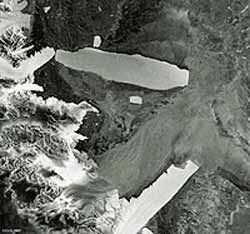In 2006, with the launch of Jules Verne, the Automated Transfer Vehicle (ATV) will become the new European powerful automatic re-supply spaceship able to bring an indispensable payload to the International Space Station and its permanent crew. This first ATV will carry a mix of supplies depending on the Station’s needs and its own payload capacity.
ESA, NASA and Russian counterparts are already defining the priorities to accommodate the most appropriate combination of different sup
A new global wind power map has quantified global wind power and may help planners place turbines in locations that can maximize power from the winds and provide widely available low-cost energy. After analyzing more than 8,000 wind speed measurements in an effort to identify the world’s wind power potential for the first time, Cristina Archer and Mark Jacobson of Stanford University suggest that wind captured at specific locations, if even partially harnessed, can generate more than eno

The mammoth B-15A iceberg appears poised to strike another floating Antarctic ice feature, a month on from a passing blow that broke off the end of the Drygalski ice tongue. As this Envisat image reveals, this time its target is the ice tongue of the Aviator Glacier.
First discovered in 1955, and named to mark the work done by airmen to open up the Antarctic continent, the Aviator Glacier is a major valley glacier descending from the plateau of Victoria Land along the west side
Wind farms are nothing new to some parts of the United States, where tall, white wind turbines with their giant propellers tower over the landscape, generating electricity with every sweep of their blades.
Now these windmills may be coming to an ocean near you — but not without significant public debate and navigation of a “hodgepodge” of regulations, according to recent University of Delaware research.
Willett Kempton and Jeremy Firestone, in the Marine Policy Program a
Summer in Europe means time for the beach. Testing the waters is a traditional holiday ritual: a swift hand or foot in the surf to check sea temperature. Or there is the modern approach – a flotilla of satellites identifying the warmest parts of all 2 965 500 square kilometres of the Mediterranean on a daily basis.
An updated map of the sea surface temperature (SST) of the world’s largest inland sea is generated every day as part of ESA’s Medspiration project, with an
The lure of a seafood diet may explain why early humans came out of Africa, according to research by the universities of Leeds and Glasgow published in Science this week.
Early modern humans in East Africa survived on an inland diet based on big game but by 70,000 years ago their diet had changed to a coastal one consisting largely of shellfish. However, dramatic climate change seems likely to have reduced the Red Sea’s shellfish stocks. New DNA evidence suggests their taste